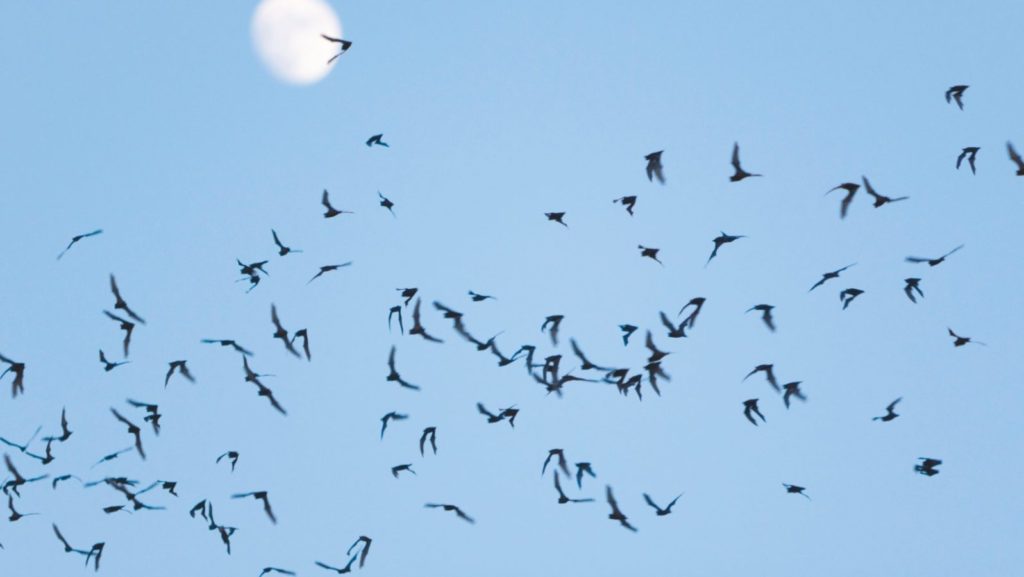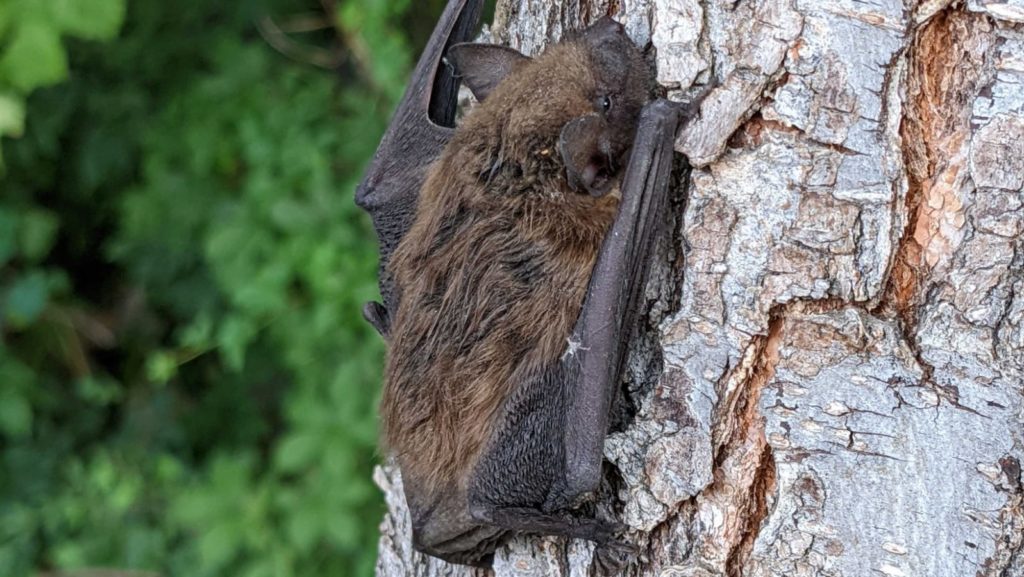Finding What’s Out There

When biologists, community scientists, Bur Oak staff and AmeriCorps members set out to discover what creatures were living at Corriell Nature Preserve, they were surprised to find an abundance of plants and animals, including an endangered species.
“With any property, we like to identify the most vulnerable species and enhance the habitat to best support that species,” said Bur Oak Land Trust Executive Director Jason Taylor. “We didn’t anticipate that bats were going to be the most vulnerable species that we found at Corriell, but that’s why you do surveys.”

Data from a specialized survey conducted over the summer revealed eight of the nine Iowa bat species, including the federally endangered Indiana bat, make their homes at Corriell. The findings also include six bat species that are listed as species of greatest concern in Iowa’s Wildlife Action Plan, and a high likelihood of the federally threatened northern long-eared bat.
“Just like bird songs, each species of bat has a unique call to it, and that’s how we identify it with acoustic recording,” said biologist Amber Schorg. “I always feel like [that fact is] pretty cool.”
Schorg, who works for the U.S. Fish and Wildlife Service in the Illinois and Iowa Ecological Services field office, advised the acoustic survey at Corriell in order to get a better picture of the bats living at the nature preserve.
“I brought out the detector,” she said, “and set it up to record on a nightly basis from a little bit before sunset all the way through a little bit after sunrise to make sure we captured all the bat activity there.”
Schorg along with Bur Oak AmeriCorps members placed the detector in the open wetland and back in the forest to capture the best flyways for the different bat species. The detector captured 14 nights of high frequency noise from the bats that ranged from 20 kilohertz, which can be heard by human ears, all the way up to 150 kilohertz. The data is georeferenced by specific times and locations on the preserve, which allows staff to pinpoint ideal land management areas to improve bat habitat.
“You can’t use a generic template for a land management plan,” Taylor said, “you have to create a plan unique to the area.”

To get a more complete picture of the Corriell landscape, Bur Oak also partnered with renowned Drake University biology professor Tom Rosburg to complete a floristic survey, a comprehensive catalog of plant species, at Corriell. Data from the 2-year project, funded by Iowa Native Plant Society and the Iowa Prairie Network, will allow the land trust to identify zones on the property that are more “ecologically significant,” Taylor said, so things like trails don’t run through sensitive prairie or trees that bats rely on aren’t unnecessarily removed.”
Bats have site fidelity and only produce one pup per year on average, Schorg said, so protecting areas where they roost and forage is particularly important. And that includes trees at all points in their life cycle.
“Each year, bats from a maternity colony – this is especially true of Indianas and northerns, as far as we know – come back to the same area to raise their young,” she said. “So when bats are found on a site, it’s ideal to keep that site protected and in a healthy state to support [bat] reproduction essentially and their growing of the next generation.”
Considering the uphill battle all bats in the state face due to urban and infrastructure development, farming, and white nose syndrome, a fatal fungus derived disease that impacts hibernating bats, these results bring hope to conservation efforts at the nature preserve.



Additional survey work at Corriell Nature Preserve was led by Don Becker who specializes in mapping reptiles and amphibians, namely ornate box turtles and mud turtles. Bur Oak AmeriCorps members painstakingly dug out pit traps and diligently checked them daily for six weeks to add to existing mapping data.
University of Iowa biology professor emeritus Jeff Klahn also spent several days over the summer collecting data on the variety of insect species at Corriell. The nature preserve, he explained, is one of several riparian and wetland reserves – areas characterized by sandy soil that is fairly uncommon in Iowa – strung out along this part of the Cedar River. Klahn, along with Bur Oak AmeriCorps member and community scientist Kristin Lee, recorded 50 bee species and hundreds of other insects.
Corriell has the great insect diversity that it does, Klahn said, including many sand-burrowing insects, due to the soil. “Habitat patches,” he said, including dense areas of flowers that support bees and wasps, can come and go depending on environmental changes or human disturbance. These insects have adapted to changing conditions by flying from patch to patch to find what they need to survive. Survival, Klahn said, depends on enough of these patches across the landscape.
“Corriell is therefore an important link in the chain of habitat patches on the Cedar [River],” he said. “Its ‘habitat health’ will contribute to the maintenance of insect populations – and everything else of course – in all these reserves.”
Plants, animals, insects and all other life thrive not only from the number of areas that guarantee food and shelter, but also from the biological diversity of those areas. Invasive species like black locust, reed canary grass and Osage orange threaten to eliminate the native plants that most of the surveyed species rely on, and ultimately decrease the number and variety of species in that place.
“I think land protection combined with stewardship actions – that part I think is pretty key – can help support the bat populations,” Schorg said, “especially the ones that remain on the landscape.”
The summer surveys are just the preliminary research opportunities that will be available at Corriell. The land trust expects to bring out other biologists, ecologists, naturalists and curious folks to the preserve to further answer the question: what’s out there?


